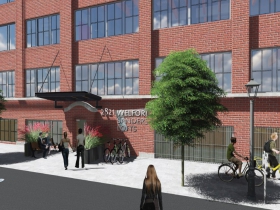Sanders Project and Legacy Celebrated
Welford Sanders Lofts on near North Side bears the name of economic development icon.
The sounds of a rainy Juneteenth Day were spilling over from the festival area on N. Dr. Martin Luther King Dr. Monday as a crowd trickled in through the freight entrance to an old industrial building on N. 4th St. that is the site of a new mixed-use development effort spearheaded and named for an economic development icon of Milwaukee’s central city.
The building, at 2821 N. 4th St., is the future site of the Welford Sanders Lofts, and local residents, tenants of the building, elected officials and developers came to the ceremonial ribbon cutting for the office space and ground breaking for the future residential units.
The $21 million development is part of a larger effort of economic revitalization for the central city, and was the last project that Welford Sanders worked on before his death.
There was much talk of his legacy at the event. Nearly every speaker mentioned that the development of this building in the Harambee neighborhood was another addition to a list of projects in the city made possible by Sanders.
Mayor Tom Barrett commented that when walking down Martin Luther King Drive or through Bronzeville you “see his handiwork. He was a guy who could get things done.”
Brenda Marquardt, marketing director for the Wisconsin Housing and Economic Development Authority, said Sanders was responsible for facilitating $62 million in investments for Milwaukee projects from WHEDA.
Sanders daughter Dawn announced a new fund, that began raising money Monday, to erect a statue of the building’s namesake somewhere on the grounds. The ceremony was the day after her third Father’s Day without her father, she said, but added, “I can’t imagine a better Fathers Day gift than to have this ribbon cutting on Juneteenth in our community.”
Gov. Scott Walker attended the ceremony and also gave a nod to Sanders, “Who’s had a lasting impact this entire area.”
Many described Sanders’ impressive work ethic. His daughter Dawn said he worked every day, even when he was in the hospital. In fact, she said his last phone call was to Bob Lemke, an associate professor of architecture at Milwaukee School of Engineering, who worked on the project with Sanders as a member of the firm Wisconsin Redevelopment.
Lemke shared with the crowd a sample of the repartee that often marked his phone calls with his late friend. It was a back and forth that he said often ended somewhere on common ground, or with a Sanders quip.
Betty Speed of the King Drive Commons residents association said, having lived in the area all her life, “I am seeing the neighborhood come back.”
The Building
The project, valued at $21 million, is redeveloping a century-old industrial building that was originally constructed as a factory for the Nunn-Bush shoe company.
Renovations for the nearly 120,000-square-foot building were split into two phases, the first being 38,000 square feet of office space and the second being 59 residential units, 47 of which will be rented at 60 percent or less of the area median income thanks to low-income housing tax credits.
Along with those tax credits, financing for the project came from a number of pots, and were fit together in a “financial puzzle,” as Ben Johnson, president of the Martin Luther King Economic Development Corporation described it.
That puzzle includes: state and federal historic tax credits, federal affordable housing tax credits, long term debt financing, and developer-financed tax-incremental financing, which Urban Milwaukee’s Jeramey Jannene described as follows: “The TIF district requires the development team to advance $1.2 million, which will be repaid via increased tax revenues on the site. The increasingly common TIF mechanism places the risk on the developer, instead of the city. If the project should fail to generate the increased tax revenue, the developer will not see a return on the money.”
Because of the TIF, the project has Small Business Enterprise and Resident Preference Program (RPP) requirements from the city. These require that about 20 percent of the contracts go to small businesses and 40 percent of the hours worked go to Milwaukee residents certified as RPP workers. In both areas the project is exceeding requirements.
Louis Thomas, a construction worker on the development, said it was the kind of project “We all prosper and get dreams out of.”
Renderings
Political Contributions Tracker
Displaying political contributions between people mentioned in this story. Learn more.
- March 30, 2016 - Tom Barrett received $25 from Ben Johnson
- December 31, 2015 - Tom Barrett received $25 from Ben Johnson


























